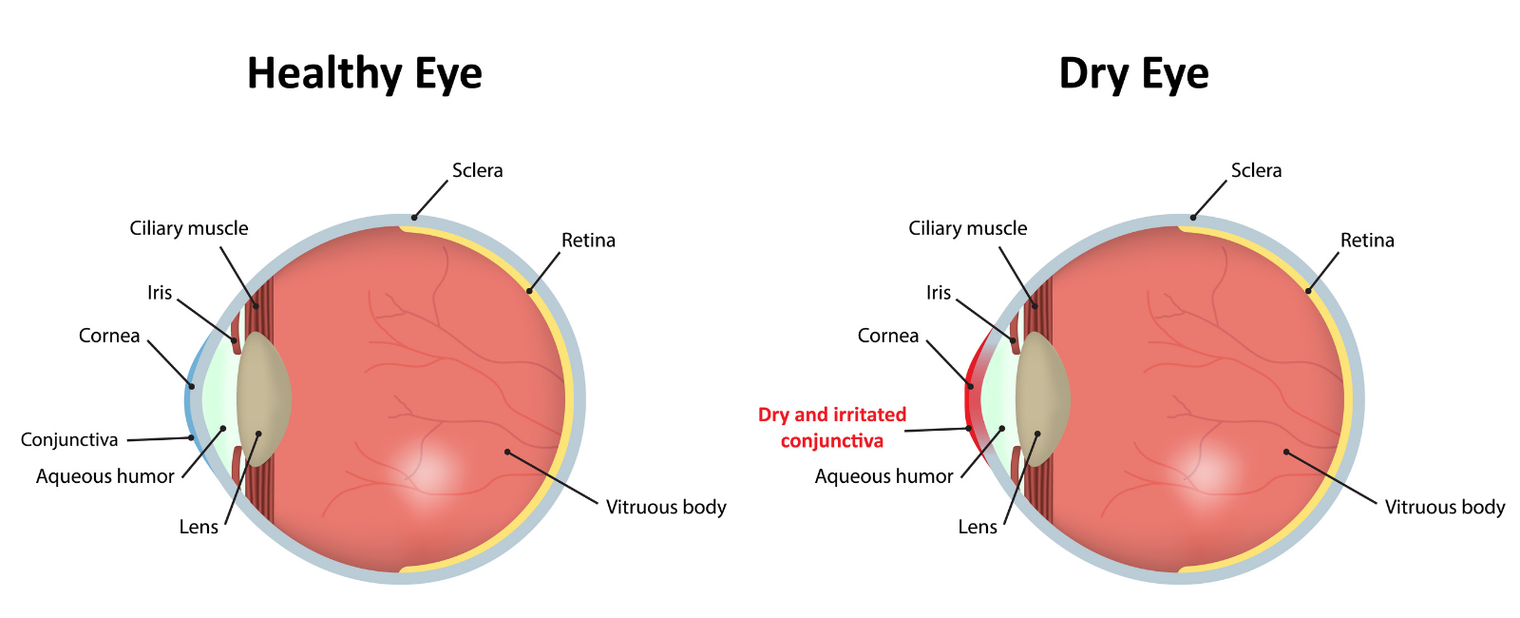Dry Eye Syndrome
Dry eye syndrome, or dry eye disease, is a common condition that occurs when the eyes don't make enough tears, or the tears evaporate too quickly. This leads to the eyes drying out and becoming red, swollen and irritated.
Dry eye syndrome is also known as keratoconjunctivitis sicca, or simply "dry eyes". It's estimated up to one in every three people over the age of 65 experiences problems with dry eyes. Dry eye syndrome is more common in women than men.
Sight Research UK supports research into all eye diseases, including dry eye syndrome.
Causes of dry eye syndrome
Dry eye syndrome can occur when the complex tear production process is disrupted in some way. There are many different reasons why this can happen, although a single identifiable cause often can't be found.
Common causes include:
- being in a hot or windy climate
- wearing contact lenses
- certain underlying medical conditions, such as blepharitis (inflammation of the eyelids)
- side effects of certain medications – including antihistamines, antidepressants, beta-blockers and diuretics
- hormonal changes in women – such as during the menopause, pregnancy, or while using the contraceptive pill
Although the condition may affect people of any age, your chances of developing dry eye syndrome increase as you grow older.
Meibomian gland dysfunction (MGD) is a blockage or some other abnormality of the meibomian glands so they don't secrete enough oil into the tears. Because the tears then evaporate too quickly, MGD is a leading cause of dry eye syndrome. It also is associated with an eyelid problem called blepharitis.
Symptoms of dry eye syndrome
The symptoms of dry eye syndrome are mild for most people, although more severe cases can be painful and lead to complications.
Symptoms usually affect both eyes and often include:
- feelings of dryness, grittiness or soreness that get worse throughout the day
- burning and red eyes
- eyelids that stick together when you wake up
- temporarily blurred vision, which usually improves when you blink
Some people may also have episodes of watering eyes, which can occur if the eye tries to relieve the irritation by producing more tears.
Although dry eye syndrome may be uncomfortable, it doesn't usually cause any serious problems. The two main complications associated with dry eye syndrome are:
- conjunctivitis– inflammation of the conjunctiva, the transparent layer of cells that covers the white part of the eyeball and the inner surfaces of the eyelids; most cases are mild and don't need specific treatment
- inflammation of the cornea– in rare cases, severe untreated dry eye syndrome can damage the surface of the cornea (keratitis); this damage can make the cornea vulnerable to ulceration and infection, which could potentially threaten your sight
Contact your optometrist or GP, or visit your nearest accident and emergency (A&E) department immediately if you have any of the following symptoms, as they could be a sign of a more serious condition:
- extreme sensitivity to light (photophobia)
- very painful or red eyes
- a deterioration in your vision

Diagnosing dry eye syndrome
Make an appointment with your optician (optometrist) if you have persistent but mild symptoms of dry eye syndrome.
Your optician will examine you to check if the problem is caused by an underlying condition, or they may refer you to an eye specialist.
Contact your optometrist or GP immediately if you have any severe symptoms. If this isn't possible, visit your nearest accident and emergency (A&E) department.
Treatment for dry eye syndrome
Dry eye syndrome isn't usually a serious condition. Treatments are available to help relieve the symptoms, which include:
- eye drops to lubricate the eyes
- medications to reduce any inflammation
- if necessary, surgery to prevent tears from draining away easily
If dry eye syndrome is caused by an underlying condition, treating this condition usually helps to relieve the symptoms.
Reducing your risk of dry eye syndrome
As well as medical treatments, there are some things you can do yourself to help prevent dry eye syndrome or reduce the symptoms:
- keeping your eyes and eyelids clean and protecting them from dusty, smoky, windy and dry environments
- using your computer or laptop correctly to avoid eye strain
- using a humidifier to moisten the air
- eating a healthy diet that includes omega-3 and omega-7 fats
Find out how Assistive Technology helps to manage tasks made difficult by low vision and blindness.
Stop the clock on sight loss
Every 6 minutes someone in the UK receives the devastating news that they are going blind. That’s 250 people a day.
Your gift can help to find new sight-saving solutions.
If you can, please donate today. Thank you.



